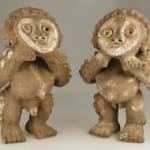Mambila Terracotta Couple, 19th Century CE - 20th Century CE
Terracotta
8.25 x 13
PF.5995
Further images
Terracotta sculptures among the Mambila are quite rare. Although most wooden sculptures represent ancestor figures, it is believe terracotta sculptures such as this couple ensured fertility and offered protection against...
Terracotta sculptures among the Mambila are quite rare. Although most wooden sculptures represent ancestor figures, it is believe terracotta sculptures such as this couple ensured fertility and offered protection against evil forces. This couple is rendered in the characteristic Mambila style, featuring the prominent heart-shaped face. The flat nose and round eyes are also typical Mambila facial features. Often, sculptures are finished with a layer of white chalk that both enhances the beauty of the work and heightens its spiritual powers. Remnants of chalk are still visible on the faces of this couple as well as the nodules that decorate the sides of their arms and legs. Both figures hold their hands alongside their chin in a gesture that must be related to their specific healing powers. However, perhaps the most distinctive feature of this couple is their unusual stomachs. Their swelling bellies with protruding navels are flat on top. This odd shape might suggest that these figures suffer from a physical ailment. In Africa, birth defects were often believed to be a good omen. Those who lived with deformities were often believed to be blessed by the spirits and in possession of enhanced supernatural powers. Given the nature of this work as a healing aid, this couple may likely represent a pair of dwarves or hunchbacks. Yet while whatever tribal powers this sculptural couple once harnessed has vanished, we can appreciate them for their overwhelming artistry. Although they no longer communicate with the spiritual world, surely their charm and beauty will enhance our lives and heal our souls.









